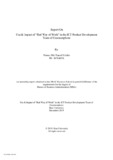| dc.contributor.advisor | Ahmed, Dr. Salehuddin | |
| dc.contributor.author | Uddin, Md.Tausif | |
| dc.date.accessioned | 2020-11-02T05:45:55Z | |
| dc.date.available | 2020-11-02T05:45:55Z | |
| dc.date.copyright | 2019 | |
| dc.date.issued | 2019-12 | |
| dc.identifier.other | ID: 16264026 | |
| dc.identifier.uri | http://hdl.handle.net/10361/14076 | |
| dc.description | This internship report is submitted in partial fulfillment of the requirements for the degree of Masters of Business Administration, 2019. | en_US |
| dc.description | Cataloged from PDF version of internship report. | |
| dc.description | Includes bibliographical references (page 35). | |
| dc.description.abstract | Grameenphone LTD, a joint venture between the Norwegian telecom company Telenor and
the Bangladeshi company Grameen Telecom is the largest mobile operator in Bangladesh.
Grameenphone has been the champion mobile operator since the embryonic stages of the
telecom industry in the country, and with more than 15,000 2G and 3G sites as well as the
growing number of 4G sites (currently more than 10,000), the Grameenphone network covers
99% of the country’s geographical area and has more than 75 million customers (as of June
2019). Grameenphone’s strategy has constantly evolved to best serve the changing market
nature of the telecom industry – from an industry whose major business was built on voice
service mostly, it quickly transformed to position itself as the number one mobile data
connectivity provider with the emergence of 3G and 4G technology. Now, in this era of 4G
and with 5G knocking at the door, Grameenphone and Telenor has already realized that the
next paradigm shift of the telecom and connectivity market would cross the traditional use of
mobile phones by customers for voice and data to digital, IoT, ICT, automation and smart
living. With the ambition to capture the number one position in the digital lifestyle of customers
as well as lead the ICT revolution in the country from the front, Grameenphone has added more
and more resources into secondary products in the niche market of ICT and IoT products such
as industrial automation, M2M communications, cloud infrastructure, software-as-a-service,
vehicle telematics, smart home, smart tracking and smart farming. The main demarcation line
was drawn out that digital apps were targeted for the consumer segment of the market (B2C)
whereas the ICT and IoT products were targeted for the enterprise or business customers (B2B).
However, with diffusion of influence and sensing market needs, this demarcation line has been
growing thinner with both streams of products being customized to be offered to more target
customers, crossing the boundary of consumer and enterprise segments. Grameenphone started
to develop products and services with less resources and exposing them to limited enthusiastic
customers. This is more commonly known as the “Red way of work” in which the target was
to capture customer feedback as fast as possible and work on them to bring new iterations of
the product, increasing the exposure to customers in the process and finally complete versions
of the products were created. As a member of the ICT Product team of Grameenphone working
as a Product Developer, I have had good exposure to these practices. This report describes the
product development and product management process of Grameenphone. A survey was
conducted to identify which of the practices are followed in the product management and
Product Development teams in Grameenphone. It was found that the development team is
following the Red Way of Work while the Product Management team follows the Blue Way
of Work. Though these teams follow different modalities for their work, it is recommended
that the values and the ways of work converge with each other in order to make this venture of
B2B business through ICT Products successful. | en_US |
| dc.description.statementofresponsibility | Md.Tausif Uddin | |
| dc.format.extent | 41 pages | |
| dc.language.iso | en_US | en_US |
| dc.publisher | Brac University | en_US |
| dc.rights | Brac University Internship reports are protected by copyright. They may be viewed from this source for any purpose, but reproduction or distribution in any format is prohibited without written permission. | |
| dc.subject | Red Way of Work | en_US |
| dc.subject | ICT Product | en_US |
| dc.subject | Development Team | en_US |
| dc.subject | Grameenphone | en_US |
| dc.title | Use & impact of “Red Way of Work” in the ICT product development team of Grameenphone | en_US |
| dc.type | Internship report | en_US |
| dc.contributor.department | Brac Business School, Brac University | |
| dc.description.degree | M. Business Administration | |

